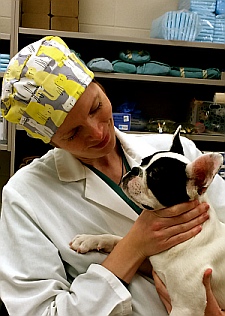“No animal should ever have to ‘qualify’ for pain medication”

Today, we publish a very interesting article dealing with the evaluation of pain in animals undergoing surgical procedures, by Dr Carolyn McKune and her group. Dr McKune has had the opportunity to work and teach at veterinary schools in the US, Canada, and the Caribbean, as well as work with pharmaceutical companies and private referral practices. She is the owner of Mythos Veterinary L.L.C.
Dr Philip Jones (@pmgjones), the Academic Editor on the paper was very enthusiastic about Dr McKune’s research: “Nobody would ever want an animal to suffer in pain after having undergone a surgical procedure. However, compared to humans, very little research has been done on how best to measure pain in animals, and, similarly, very little is know about how best to treat pain in animals. Since I am an anesthesiologist, frequently dealing with pain issues (in humans — who can tell me when something hurts!), I was fascinated by Dr McKune’s novel research on pain after ovariohysterectomy in dogs. She and her team performed a three-arm clinical trial hoping to find a method of reducing pain after this procedure. Important insights into the measurement and treatment of pain in dogs were obtained from this clinical trial. I hope that more and more academic veterinarians will undertake similar research with the goal of perioperative pain reduction in animals.”
We were very interested in this work and felt it would be informative to have Dr McKune answer a few questions.
PJ: What is the take-home message of your article?
CMM: The take home message of our manuscript, “Challenges in evaluation of pain and a pre-incisional line block”, is simple: pain in animals is difficult to successfully detect. Those of us privileged enough to work with animals are obligated to understand this fact when managing their pain, and provide analgesia when we anticipate pain is present.
PJ: What challenges did you face while doing this research?
CMM: There are numerous challenges when one is performing a research project in clinical subjects. Personally, the hardest part of this project was that, in order to study their pain, I had to knowingly allow an animal to become painful. While mentally I anticipated this would be challenging, this was compounded by the fact that many of the shelter dogs were a variety of a very stoic dog breed—the pit bull. It was heart breaking to see these dogs which were so submissive to their human (hence, why people have tragically used these guys for dog fighting) that they would not show me ANY behavioral signs of pain. It was very distressing to know some of these animals had no analgesia present, and yet they calmly let me handle them, palpate near their wounds, etc. It was if they were saying “I have a human being to touch me; what more could I need?” It was just heart breaking. This really drove home for me the take home message of this article—no animal should ever have to ‘qualify’ for pain medication. They should receive analgesia because we know logically they are in discomfort. We should also treat them with great respect and kindness, so we are worthy of the trust they place in us.
PJ: What kind of lessons do you hope the audience takes away from your research?
CMM: It is tempting to say, based on this research, that something like an ovariohysterectomy (commonly known as a “spay”), is not painful. However, this is highly unlikely to be the case—what human being, with the ability to verbally communicate, would consider a major abdominal procedure not painful? It is much more likely that pain is subtle in nature, animals are stoic, and even when using multiple assessment tools, we (who are not experiencing the procedure ourselves) are unlikely to accurately quantify pain in each and every patient. The inability to verbally communicate is an obstacle that we simply cannot over come, and therefore the onus is on us to provide adequate analgesia to any patient undergoing a procedure that is painful for a verbal responder.
PJ: How did you first hear about PeerJ, and what persuaded you to submit to us?
CMM: It was actually my husband (Michael J. Dark), who has published with PeerJ that suggested submitting to PeerJ. I’m very glad he did.
PJ: What was your experience of the review process?
CMM: I had an excellent editor and reviewers, who definitely enhanced the quality of the submission through their thorough review.
PJ: Anything else you would like to highlight?
CMM: PeerJ has an excellent staff. Because of the degree of automation used by PeerJ in the submission process, I assumed the responses to submitting authors would be robotic. Nothing could be further from the truth. I actually feel like I know some of the PeerJ staff personally now, and am very impressed with their efficiency and dedication.
PJ: In conclusion, how would you describe PeerJ in three words?
CMM: Worthy of Opus One (www.opusonewinery.com) 🙂
PJ: Many thanks!
Join Dr McKune, and thousands of other satisfied PeerJ authors – send your next article to PeerJ!

